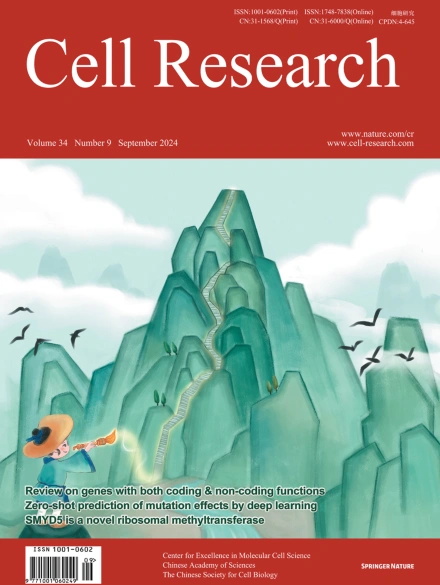
Advanced Search
Submit Manuscript
Advanced Search
Submit Manuscript
Volume 34, No 9, Sep 2024
ISSN: 1001-0602
EISSN: 1748-7838 2018
impact factor 17.848*
(Clarivate Analytics, 2019)
Volume 34 Issue 9, September 2024: 648-660 |
SMYD5 is a ribosomal methyltransferase that catalyzes RPL40 lysine methylation to enhance translation output and promote hepatocellular carcinoma
Bisi Miao1,† , Ling Ge1,† , Chenxi He1,† , Xinghao Wang2,† , Jibo Wu3,† , Xiang Li4 , Kun Chen1 , Jinkai Wan1 , Shenghui Xing1 , Lingnan Ren1 , Zhennan Shi1 , Shengnan Liu2 , Yajun Hu1 , Jiajia Chen1 , Yanyan Yu2 , Lijian Feng2 , Natasha M. Flores3 , Zhihui Liang1 , Xinyi Xu1 , Ruoxin Wang1 , Jian Zhou1 , Jia Fan1 , Bin Xiang2 , En Li2 , Yuanhui Mao5 , Jingdong Cheng4 , Kehao Zhao2 , Pawel K. Mazur3,* , Jiabin Cai1,* , Fei Lan1,*
11 Shanghai Key Laboratory of Medical Epigenetics, International Co-laboratory of Medical Epigenetics and Metabolism, Ministry of Science and Technology, Institutes of Biomedical Sciences, Key Laboratory of Carcinogenesis and Cancer Invasion, Ministry of Education, Liver Cancer Institute, Zhongshan Hospital, Fudan University, Shanghai, ChinaWhile lysine methylation is well-known for regulating gene expression transcriptionally, its implications in translation have been largely uncharted. Trimethylation at lysine 22 (K22me3) on RPL40, a core ribosomal protein located in the GTPase activation center, was first reported 27 years ago. Yet, its methyltransferase and role in translation remain unexplored. Here, we report that SMYD5 has robust in vitro activity toward RPL40 K22 and primarily catalyzes RPL40 K22me3 in cells. The loss of SMYD5 and RPL40 K22me3 leads to reduced translation output and disturbed elongation as evidenced by increased ribosome collisions. SMYD5 and RPL40 K22me3 are upregulated in hepatocellular carcinoma (HCC) and negatively correlated with patient prognosis. Depleting SMYD5 renders HCC cells hypersensitive to mTOR inhibition in both 2D and 3D cultures. Additionally, the loss of SMYD5 markedly inhibits HCC development and growth in both genetically engineered mouse and patient-derived xenograft (PDX) models, with the inhibitory effect in the PDX model further enhanced by concurrent mTOR suppression. Our findings reveal a novel role of the SMYD5 and RPL40 K22me3 axis in translation elongation and highlight the therapeutic potential of targeting SMYD5 in HCC, particularly with concurrent mTOR inhibition. This work also conceptually broadens the understanding of lysine methylation, extending its significance from transcriptional regulation to translational control.
https://doi.org/10.1038/s41422-024-01013-3